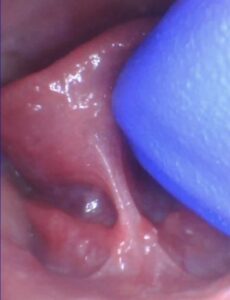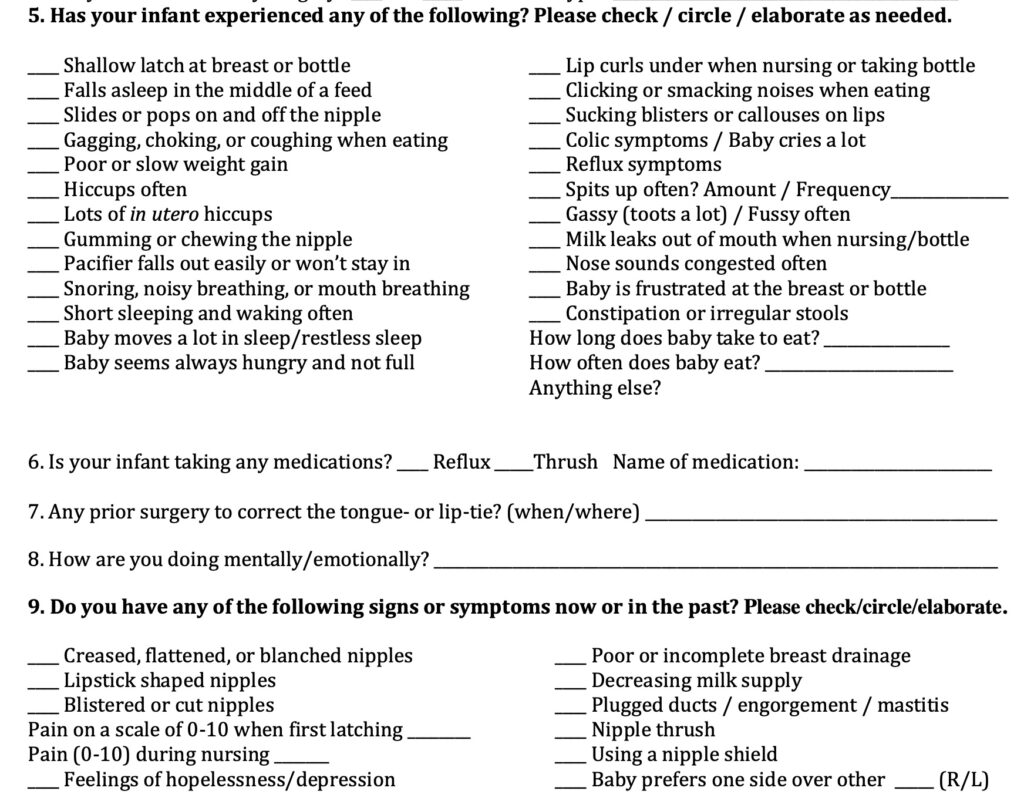New parents are tasked with figuring out how to care for their new baby with no user manual (well, there are books and Dr. Google, at least). Still, one of the most frustrating aspects of the infant stage is when babies cry for no apparent reason, wake up crying or screaming, or can’t seem to stop crying. Colic stresses parents, marriages, siblings, and grandparents, and if there is one overlooked solution to the madness of colic, providers and parents should know about it. Tongue-tie, or having a restricted tongue, is an underappreciated cause of many babies having crying episodes (which may or may not qualify as colic). Colic is a symptom, not a diagnosis. It is the baby trying to tell you something – they don’t feel well.
Infant Colic or excessive crying is diagnosed by episodes of crying lasting more than three hours, more than three times a week, for more than three weeks, but only after ruling out any other possible causes. Colic affects 10-40% of babies, and the only real treatment, according to experts, is to reassure parents that it will go away in 4 to 6 months. Colic or excessive crying is common in babies, but it is not normal. Just because something is common does not mean it is normal.
Another common condition that affects breastfed and bottle-feeding infants that is typically missed, even by great pediatricians who we respect and admire, is a tongue-tie or tongue restriction. Some tongue-ties are to-the-tip and should easily be identified in the hospital by the pediatrician or lactation consultant. However, another presentation of tongue-tie can be a less obvious and often undetected form called a posterior tongue-tie, meaning the string under the tongue is not to the tip and is maybe 50% of the way to the tip, or in some cases just 25% of the way to the tip (see photo below).

A posterior tongue-tie can cause all the symptoms of a more obvious version, including painful nursing, slow weight gain (sometimes), gassiness, fussiness, spitting up, reflux, and excessive crying or colic. Just because a baby is gaining weight does not mean they are “fine.” Tongue-tie is said to affect 4-10% of newborns, but if you include posterior tongue-tie, the percentage of babies or children affected jumps to between 26% and 32.5%, according to studies. That’s getting closer to the 10-40% of babies affected by colic.
Many ENTs, pediatricians, and other professionals working with babies deny the existence of tongue-tie, or at least they did until October of last year when a randomized controlled trial by Dr. Ghaheri was published in the official ENT journal. Using a special bottle that measures sucking ability, he demonstrated with objective data that releasing a posterior (less obvious) tongue-tie changes the way babies suck and affects bottle-feeding, reflux, nipple pain, and maternal confidence in feeding the baby. We see these issues improve every day in our office after a tongue-tie release, so it’s nice to see a study that validates the improvements tongue-tie providers see worldwide after proper treatment.
Are all cases of colic caused by a tongue-tie? No. However, many cases of colic can likely be helped by having a proper assessment and diagnosis for tongue-tie before settling on a colic diagnosis and closing the case. After all, colic is a diagnosis of exclusion, which means you have to run through all possible causes when giving out that diagnosis. Unfortunately, tongue-tie, and specifically posterior tongue-tie and a lip-tie (a restrictive upper lip frenum), are not even on the list of diagnoses that pediatricians assess. A simple change would be for providers seeing babies to at least put the possibility of a tongue- or lip-tie on the list (and have a high degree of suspicion) when they see a fussy baby and a family struggling.
Check out some of our earlier posts to learn more about assessment and treatment. A simple test is to lift up your baby’s lip, and if the upper lip frenum turns white (blanches) or causes distress, it is likely too tight. If you run your finger under the tongue back and forth and feel a tight string, or when the baby is crying, the tongue stays in a lower position, those are concerning signs of restriction. Lift under the tongue and see how high it lifts and where the string attaches. Just because you can’t see a string doesn’t mean it’s not restricted. Some posterior ties are hard to detect even by medical professionals.
How can a lip- or tongue-tie lead to colic? In our office, the colicky babies seem hungry and gassy or full of air in their bellies and are trying to tell you they are unhappy. We like to say colic is a symptom, not a diagnosis. Why is the baby fussy and colicky? A tongue-tie (any degree of tongue restriction) can lead to a poor latch at the breast or bottle, and a lip-tie can lead to a poor seal when feeding because the lip cannot flange normally. When this happens, a clicking or smacking noise often accompanies feeding, and babies swallow too much air. Air gets in the belly and has to go somewhere, so it comes up as burps, reflux, or spitting up; or it goes down, and the baby has excessive gas. The air in the belly causes discomfort and possibly excessive fussiness and crying.
If the tongue is restricted, the baby cannot feed efficiently, so they get less milk, are often constantly hungry, wake up crying from hunger, sometimes have weight gain issues, and can be hangry – which leads to colicky symptoms as well. Check out our infant checklist for tongue-ties (below), and if your baby has more than a few checkmarks, the chances of them having a tongue-tie or lip-tie are pretty high. And unsurprisingly, in our experience, once the root cause is treated, most babies have much less crying and are happier.

What can be done? The procedure is simple, but it must be done by someone with experience assessing, diagnosing, and treating properly, and aftercare exercises must be performed to prevent reattachment. A snip or clip with scissors often does not yield much improvement. With a proper exam coming from behind the baby and lifting up with two fingers under the tongue and lip; a complete release of restricted tissue; aftercare stretches for three weeks to prevent reattachment; follow-up visits; and a team approach to care, then a resolution of symptoms for mother and baby are very likely. If you leave out any one of these steps, the procedure will not work as well as it could.
This is why some pediatricians say tongue-tie procedures don’t work, are a fad, or are overperformed. If you just take out one tonsil or half the cavity in a tooth, you shouldn’t expect the procedure to work. But when properly performed with a full release at our office, we see clinically, and studies support a high degree of success in the 95% or greater range with better feeding and thus happier babies after a tongue-tie release.
If you are struggling with a fussy, colicky, difficult baby, please reach out to our office, send us a message or call us at (205) 419-4333, and we would love to help you and your baby. No families should have to go through the several months of colic that many families do until it just “gets better.”
There are also state-specific Facebook groups where moms provide support (search “[State name] tongue-tie support group” on Facebook), and you can find a local provider to help assess properly. Tongue-tie and lip-tie treatment are typically not taught in medical, dental, lactation, speech, or other professional schools, so unless a provider has had a personal experience and sought out extra training, their assessment is likely incomplete. This is not their fault but rather due to a systemic lack of education on the subject.
To learn more about tongue-ties, you can also check out our bestselling book, Tongue-Tied, or a provider can get trained with our online course, Tongue-Tied Academy.
